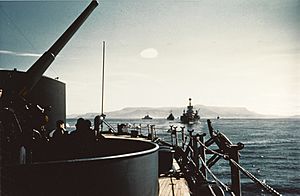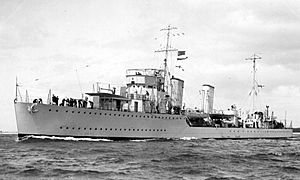Allied occupation of Iceland facts for kids
During World War II, the country of Iceland was taken over by the Allied forces. This started with a British invasion called Operation Fork. The goal was to stop Germany from using Iceland as a base. The Royal Navy and Royal Marines carried out this plan. Over time, soldiers from Canada and then the United States joined the British troops, even though the U.S. was not yet officially in the war.
Contents
Why Iceland Was Occupied
At the start of World War II, Britain wanted to stop Germany from getting supplies. So, Britain put strict rules on goods leaving Iceland. This meant Iceland could not sell things to Germany. Britain offered to help Iceland if they joined the Allies, but Iceland said no. They wanted to stay neutral.
However, Germany had diplomats in Iceland, and the island was very important strategically. This worried Britain. On April 9, 1940, Germany took over Denmark. The King of Denmark was also the head of state for Iceland at that time. Because Iceland would not join them, the British decided to invade on May 10.
The British Invasion
The first British force had 746 Royal Marines. They landed in Reykjavík, the capital city. They met no resistance. The troops quickly cut off communication lines, secured important places, and arrested German citizens. They used local transport to move to other areas like Hvalfjörður and Akranes. Their aim was to protect landing spots in case Germany tried to fight back.
The government of Iceland protested the invasion. They said it broke their neutrality and independence. Britain promised to pay for any damage, make good business deals, and leave Iceland after the war. Iceland's leaders accepted the situation, working with the British even though they officially stayed neutral.
More British soldiers arrived soon after. By July 1940, Canadian forces also landed. Eventually, about 25,000 Allied soldiers were in Iceland. A year after the invasion, American troops arrived by agreement with Iceland, even though the U.S. was still neutral. After the U.S. joined the war in December 1941, their forces grew to about 30,000 soldiers.
Life Under Occupation
British Troops in Iceland
The British military formed a group called Alabaster Force to permanently occupy and defend Iceland. More troops arrived in May 1940. Over the summer, more soldiers came, along with artillery, anti-aircraft guns, and construction teams. By July 1941, there were over 25,000 British soldiers on the island.
The soldiers immediately started building airfields, harbors, roads, and other important facilities. Hvalfjörður became a major naval base for ships protecting merchant convoys and hunting submarines. This base had many facilities, including a mine depot, piers, and fuel storage. It was protected by mines, anti-submarine nets, coastal guns, and anti-aircraft batteries.
The Royal Air Force (RAF) and Royal Canadian Air Force (RCAF) also used two airfields, RAF Kaldadarnes and RAF Reykjavik. They flew patrol, reconnaissance, and anti-submarine missions. British warships like HMS Devonshire and King George V visited Icelandic harbors. Hospitals were also built to care for soldiers.
After the war, most British facilities were given to the Icelandic government. About 199 Commonwealth soldiers are buried in Iceland.
|
|
|
Canadian Troops in Iceland
In May 1940, Britain asked Canada to send troops to defend Iceland. Canadian Prime Minister Mackenzie King said that controlling Iceland was very important for protecting shipping lanes and North America.
A Canadian force called "Z" Force arrived in Reykjavik in June 1940. More Canadian soldiers came in July. They spread out across the island, building defenses, roads, and improving harbors. They also set up coast watch stations. In February 1941, Canadian forces even engaged a German aircraft flying over the island.
Because Canada needed its soldiers elsewhere, many Canadian troops left Iceland by April 1941. British forces temporarily replaced them. Then, on July 7, 1941, the defense of Iceland was officially handed over to the United States. However, Canadian army, navy, and air force units continued to operate in and around Iceland throughout the war. For example, No. 162 Squadron RCAF helped protect shipping routes and even sank a German submarine in 1944.
|
|
|
United States Troops in Iceland
Britain needed its soldiers for other battles, so they asked the U.S. to take over the occupation of Iceland. The U.S. agreed on June 16, 1941. The 1st Provisional Marine Brigade sailed from the U.S. and arrived off Reykjavik on July 7. The United States Marine Corps began landing on July 8.
On August 6, the United States Navy set up Naval Air Station Keflavik in Reykjavik. United States Army personnel also started arriving in August.
|
|
|
|
What Happened After
Britain invaded Iceland to stop Germany from taking it over. They also wanted a base for naval and air patrols to protect ships crossing the Atlantic. The invasion and occupation were successful in these goals.
However, having British, Canadian, and U.S. troops in Iceland had a big impact on the country.
| Year | Soldier count |
|---|---|
| 1940 (after May) | 20,000 |
| 1941 | 25,000 |
| 1942 | 30,000 |
| 1943 | 30,000 |
| 1944 | 15,000 |
| 1945 | 7,000 |
In some years, the number of foreign soldiers was equal to 25% of Iceland's total population. This was almost half of the native male population.
Icelanders had mixed feelings about the occupation. Some called it the "Lovely War" because it brought economic growth. Others worried about losing their independence and the social changes it caused. The occupation led to the building of many roads, hospitals, harbors, and airfields, which greatly helped Iceland's economy.
During the occupation, on June 17, 1944, Iceland declared itself a republic. They continued to work with the Allied military but remained officially neutral. After the war, the Keflavík Agreement in 1946 said that the American army would leave Iceland within six months. Iceland would then take over Keflavík Airport. However, a large U.S. military presence stayed in Iceland until September 30, 2006.
Even though Britain invaded to prevent a German takeover, there is no clear proof that Germany had a definite plan to invade Iceland. However, Germany was interested in it. A German general named Walter Warlimont said that Hitler wanted to occupy Iceland to stop anyone else from being there. He also wanted to use it as an air base for German submarines. After the British invasion, Germany studied the idea of invading Iceland themselves, in a plan called Operation Ikarus. But they decided it would be too difficult and costly to keep supplies going to Iceland.
See Also
- Ástandið
- Invasion of Iceland
- Iceland in World War II
- British occupation of the Faroe Islands
- Expansion operations and planning of the Axis Powers
- Battle of the Atlantic
- Occupation of Greenland



